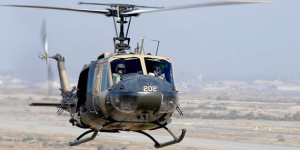
EDITORIAL – By February 1971, ARVN (acronym for the Army of the Republican of Vietnam; pronounced AR-vin) had undergone a purported transformation by U.S. policymakers. Vietnamization, the Nixon administration’s policy to train and transfer combat authority and autonomy to Vietnamese soldiers, with U.S. forces serving in a support capacity, was in full swing. For nearly three years ARVN had been bolstered and reinforced with U.S. training, weapons, and logistical support. In the eyes of the Nixon administration, if “peace with honor” were to come in Southeast Asia, the Vietnamese people must be able to fight, and win, on their own—without the aid of the U.S.
The first significant test of Vietnamese forces came in an operation beyond the Laotian border. ARVN was tasked with clearing enemy resistance and supply caches along the Ho Chi Minh trail—a colloquialism for the communist supply network used to funnel troops and munitions into South Vietnam. Thus in early-February 1971, a joint task force of South Vietnamese ground forces and U.S. air support departed the U.S. Marine outpost at Khe Sanh on Highway 9 for the Laotian border. The offensive would come to be known as Lam Son 719. At the onset of the U.S.-ARVN offensive, North Vietnamese military commanders in Hanoi were distracted with other pressing concerns and the first several days of the operation proved fruitful for both ARVN and U.S. policymakers, who had a great deal riding on the overall success of the mission in order to validate Nixon’s Vietnamization program.
Nevertheless, the North Vietnamese Army (NVA) would take advantage of slowing ARVN forces and mount a significant counteroffensive. Despite U.S. air reinforcements dispatched from Khe Sanh, the South Vietnamese army was wholly unable to regain its momentum against a mounting communist assault. Although ARVN destroyed significant NVA logistical sites and infrastructure, the result was clear: ARVN was not combat ready against a more formidable NVA. The results were ominous, to say the least. If the finest ARVN units could not suppress an NVA attack, with significant U.S. air support, how were they supposed to wage a protracted conflict against communist forces without U.S. assistance? Left on the battlefield of Lam Son 719 was any hope of South Vietnamese combat autonomy, and more importantly, peace with honor in Vietnam.
Iraq, 2014. An al-Qaeda aligned group, Islamic State in Iraq and Syria (ISIS), has emerged as the preeminent jihadist group resisting both the governments of Iraq and Syria. The terrorist group’s strength is thought to be in the thousands and led by terrorist Abu Bakr al-Baghdadi. Early in 2014, ISIS gained control of Fallujah in the western portions of the Anbar province. Soon after taking Fallujah, ISIS seized Ramadi, the Anbar provincial capital, and has slowly amassed a significant ‘caliphate’ within Iraq and Syria. Near its peak, ISIS controlled most of Anbar, as far north as Mosul, and as far east as Tikrit. In Syria, ISIS has controlled a swath of land, principally, along the Euphrates River, from the Iraqi border in the south to the Turkish order in the north.
ISIS has taken control of Iraqi oil fields and the Mosul Dam, Iraq’s largest hydroelectric power station, located on the banks of the Tigris River. Additionally, there are reports of ISIS implementing a bastardized and radicalized version of Islamic law, unilaterally executing political and religious minorities, including Christians, in a variety of ways—including beheadings, crucifixions, and other forms of brutality. President Barack Obama has ramped up U.S. airstrikes on critical ISIS targets, but he has noted that the U.S. cannot act as “the Iraqi air force” in perpetuity. The president noted that the U.S. has a strategic interest in the region to ensure that ISIS doesn’t carve out a radical Islamic caliphate across international borders and threaten both regional and global stability. The U.S. military operation is largely limited to strategic airstrikes to support Iraqi forces on the ground, though President Obama had dispatched several hundred U.S. military advisors to the region, in order to assist Iraqi security forces with strategic military planning.
Late Sunday night, Kurdish pesh merga forces launched an intense assault against ISIS militants in order to retake the Mosul Dam. As of Monday afternoon, several Kurdish sources have confirmed that they have retaken the dam and routed ISIS militants from the site. Further, Kurdish soldiers have been reported to have retaken two predominantly Christian towns, Batmaiya and Telasqaf, as they contemplate an audacious push toward retaking the city of Mosul from ISIS fighters.
The newfound momentum on the part of U.S.-allied fighters is a recent development. ISIS has been aggressive in their offensive, taking control of U.S.-supplied Iraqi armored personnel carriers, Humvees, and artillery pieces. In fact, it was a little over one month ago that ISIS had begun amassing personnel and equipment near Baghdad, in what appeared to be an impending ISIS offensive on the Iraqi capital. As one observer noted, the possibility of a fall of Baghdad evokes the poignant images of Saigon 1975—the fall of Saigon and the de facto communist takeover of South Vietnam.
Could Iraq in 2014 be a repeat of Vietnam in the mid-1970s? The answer is simple: only if we repeat the mistakes of history and abandon the Iraqi people, like the Vietnamese.
We abandoned the Vietnamese—because of politics. The war became unpopular, so Congress limited the scope of U.S. intervention. Vietnamization promised an autonomous Vietnamese military, results proved otherwise. The strategy of “hearts and minds” hinged on pacifying the Vietnamese people; Viet Cong (VC) support never truly wavered in the countryside—its primary base of support. And the Nixon administration spoke of a victorious and honorable peace. The images of tear gas sprayed to suppress South Vietnamese citizens seeking refuge during the fall of Saigon do not lend themselves to any semblance of an honorable peace. The resounding lesson of Vietnam is that no amount of money, manpower, and, most importantly, firepower can suppress a revolution-from-below, or a true populist revolution—whether that revolution is communistic or democratic, it makes no substantive difference with regards to the movement’s overbearing legitimacy in the state undergoing a transformation.
Naturally, we will wonder: how long is this conflict in Iraq going to continue? How much more American aid and how many more American lives must be lost to advance the cause of Iraqi democracy? If we leave Iraq, it will almost surely go the way of South Vietnam, a byword, consigned to the annals of history. If we leave Iraq, we equivocate not only on our commitment to its people, but on our commitment to be the arbiters of global stability and democracy. We must let every nation and people know that when an ally of the U.S. is attacked, when its people are slaughtered for their religious convictions, and when U.S. interests hang in the balance—the United States will always answer the call.
If the U.S. helps to continue to rout the ISIS threat, it will send a message to the next ISIS, to the next terrorist group who seeks to commit barbaric acts against an ally, we’ll be there. We must remember that the war in Iraq was a conflict predicated on shoddy intelligence and post-9/11 fear and hysteria, but we must now stand for democracy; democracy not just for the Iraqi people, but democracy, generally, wherever and whenever it is threatened by those who place a higher value on anarchy and senseless violence.
For that, we must stand with Iraq, resist ISIS, and ensure that Iraq does not go the way of Vietnam. The fear which resounds in the mind of this author, ISIS attacking Iraqi security forces and gaining control of Iraqi territory and U.S. made weapons systems, harkens back to Lam Son 719. It does not appear that the Iraqi military is ready to wage a protracted conflict without U.S. aid, much like South Vietnam in the early-1970s. If that is the case, we should be very concerned for the future of “the land between the rivers.”











